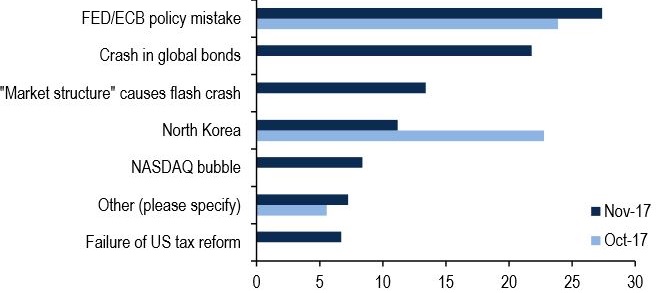One of the top three worries for investors right now is a crash in global bond markets.
When asked what poses the biggest “tail risk,” or worry for the financial market, 22 percent of global investors considered the biggest risk to be a sharp drop in bonds, according to Bank of America Merrill Lynch’s November Global Fund Manager Survey out Tuesday.
That’s just below the 27 percent of respondents that fear mistake in monetary policy by the Federal Reserve or European Central Bank the most.
Just 13 percent were most worried about a “market structure”-generated flash crash.
What do you consider the biggest “tail risk”?

Source: Bank of America Merrill Lynch, November Fund Manager Survey
Bond prices fall when yields rise, and some key global bond yields have climbed to multi-year highs in the last few days. The iShares iBoxx $ High Yield Corporate Bond ETF (HYG) was tracking Tuesday for its lowest close since March.
“If you see further weakening in bond markets, particularly credit bond markets or corporate bond markets, it’s going to have a negative impact on stock markets,” Michael Hartnett, chief investment strategist at BofAML, told CNBC in a phone interview Tuesday.
Global bond yields have come a long way since hitting historic lows on July 11, 2016, a date Hartnett has called “a massive, secular inflection point” that will have major effects.
In the U.S., Treasury yields have climbed in the last few weeks amid expectations of tighter monetary policy and an increased deficit under tax reform. In China, Beijing’s focus on reducing dependence on high credit growth has raised worries about tighter monetary policy and slower economic growth.
The Chinese 10-year sovereign bond yield hit 4.033 percent overnight, its highest since Oct. 14, 2014.
“China’s bond [yield] hitting that 4 percent level has to do with post [National Communist Party] Congress, people are concerned about deleveraging,” said Marc Chandler, chief currency strategist at Brown Brothers Harriman.
The U.S. 2-year Treasury yield traded Tuesday near 1.69 percent, near its highest since Oct. 21, 2008. The Federal Reserve began unwinding its balance sheet in October by reducing its bond purchases and is expected to raise short-term interest rates in December.
The benchmark U.S. 10-year Treasury yield traded mildly lower around 2.38 percent, near the higher end of a post-election trading range. German and Japanese 10-year sovereign bond yields have also climbed solidly into positive territory after turning negative last year.
When BofAML conducted the survey from Nov. 3 to 9, a near-record 81 percent of respondents said bond markets are overvalued.
Top “tail risk” for fund managers (Oct. 2015 – Nov. 2017)

Source: Bank of America Merrill Lynch, November Fund Manager Survey
The latest BofAML survey had 178 participants with $533 billion in assets under management.
To be sure, fund manager fears can be misplaced. The top worry from July to September last year was “GOP wins White House.” U.S. stock index futures plunged on election night but quickly recovered and have surged to record highs following Republican President Donald Trump’s surprise election win.
“There is no fear of the Fed. None. And until there is it’s going to be difficult for markets to go down in a big way,” Hartnett said.
“The catalyst has to be inflation, especially wage inflation,” he said.
Average hourly earnings posted a 2.4 percent increase in the 12 months through October, down from a 2.9 percent annualized increase in September.
— CNBC’s Patti Domm contributed to this report.
Source: Investment Cnbc
A bond market crash is a growing worry for investors